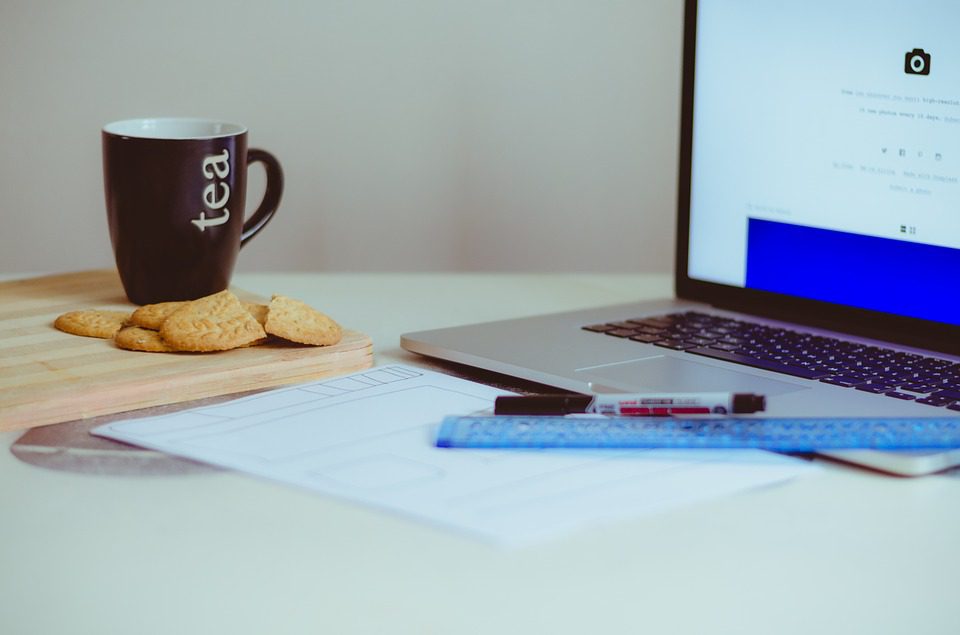by Damon Burton @ Utah Sites | Feb 12, 2018
Minimalism is currently one of the most popular types of web design. It has features and advantages that will make a lasting impression on the design landscape and is simplicity makes it attractive to potential customers.
A minimalist website is aesthetically pleasing, compelling, information-rich, and easy to navigate. It provides a gratifying experience to users who are not looking to scan through untold quantities of pages of content.

(Pixabay / rawpixel)
Advantages of minimalist web design
The professional look of minimalist design makes your website stand out from the crowd. It prioritizes information by eliminating “background noise” and including only the most relevant content. Here are some of the advantages of a minimalistic design.
- Easier to maintain than more complex sites.
- The pages load faster because there is less code.
- It is also less likely to go out of style soon because of its simplicity.
A minimalist website creates an environment that allows readers to focus on your products or services instead of the complexity of your site. It can easily guide readers in a certain direction, resulting in higher retention, more sales conversions, and a positive impression of your brand.
However, as with everything, there are cons for every pro.
Disadvantages of minimalist web design
Minimalist design isn’t for everyone. Some people feel that over-emphasizing simplicity might give viewers the impression that your site is unfinished. You can counter this notion by using spaced-out design elements and rich content.
Another drawback of this design style is that it can limit growth. You start with the basics, but what happens when your business expands? Will the no-frills design template enable you to accommodate new information and images?
If you are concerned about the limits of minimalist design, make sure to plan well in advance. Build on a heavy-duty framework that will enable you to keep on growing and expanding, even with a minimalist design.
by Damon Burton @ Utah Sites | May 22, 2017
Minimalist web design simplifies interfaces by eliminating unnecessary content or elements that are not supportive of user tasks. It limits design to the most essential and basic elements. In essence, minimalist web design strips things down to the simplest form needed to make a design function.

(Pixabay / Unsplash)
Minimalist web design can strike a balance between functionality and aesthetics with bold use of space, striking typography, stunning visuals, and a focus on the content itself. The following are the assets that make minimalist web design a popular choice:
- Negative space – Minimalist web design is heavy on negative space. However, it is more than a small visual in the middle of a colorless expanse. It also covers space using dark backgrounds, black, or white. Some designers use full-color backgrounds to express negative space. The space can manipulate the user’s visual flow, as the eye is drawn to an element when there is more negative space around it.
- Large and vivid photography – The use of oversized images can add a touch of familiarity to minimalist sites that lack emotion. The use of hero headers as well as hero images significantly improves the emotional aspect of a website’s design.
- Dramatic typography – With many website elements eliminated, emphasis on typography becomes the focal point of a minimal framework. Typography brings focus to the content while creating an intriguing visual.
- Beautiful contrast – Designers can create impressive contrast with color, shape, size, scale, and element location. Backgrounds may be overlaid with bold images or colorful elements.
- Simple navigation – The use of the hamburger menu has taken over the traditional navigational tools in an attempt to further limit UI elements.
- Visual harmony – Minimalist design requires a solid backbone. Its visual organization should include a strong grid, attention to alignment, and visual balance.
- Flat design – Flat design works with minimal frameworks by toning down the abundance of bright colors. Flat design reduces the emphasis on design tricks, with stripped-away concepts pairing well with the minimalist philosophy.
Minimalist web design is not simply taking away elements. It requires expertise and a sharp eye to prevent the design from becoming inefficient. Mastering the pillars of minimalism will result in a sleek, content-focused website.
by Damon Burton @ Utah Sites | Dec 29, 2020
Web design plays a significant role in determining page rank, as well as boosting customer experience on a website. As best practices are always changing and evolving, we asked business owners what they thought would be important to remember in 2021 to build and manage a successful site. Read below to see what they had to say.
The Advancement Of Chatbots In 2021
One thing I’m interested in is the advancement of chatbots in 2021. It feels like client-side AI has become much more advanced in just the last few years. The algorithms controlling the responses are tighter and often much more comprehensive. Many customers can be helped through chatbot alone. It is a great resource in addition to standard customer service.
I’d like to see chatbots speak in more conversational tones, however. Right now, they still definitely sound like AI. While there’s no need to “trick” customers into thinking they’re talking to real people, chatbots can only be improved by having more intuitive responses that fall in line with those of a human.
Dark Mode Websites and High-Performance ChatBots
Web design is very important for any website because it is one of the marketing materials that introduces your brand to people. As an online business owner, I always invest in redesigning my website to provide an exceptional experience to my customers.
Here are my top 2 web design trend for 2021:
Dark Mode Websites: Dark modes are being popularized now and used with applications. This dynamic design can actually trend in 202. People prefer using dark modes because they can feel that their eyes are more relaxed than with traditional web design.
High-Performance ChatBots: There are many websites nowadays that use chatbots to entertain visitor’s queries, and chatbots are expected to improve significantly to talk like a normal person. This means that they will be so much more effective than in the past.
Scot Chrisman, Chief Marketing Officer at
NWT3K.
My Web Design Trends For 2021
Technology development is fast-phased, and so is web design. Your website is the “silent ambassador” of your brand. It gives your clients the impression of who you are and what you do. If it is beautifully designed, intelligently built, and provides up-to-date technology, it will keep the existing users and bring in new ones. As for me, here are the web design trends for 2021:
Minimalism – “Less is more” is back. It is commonly known as flat designs with a clean and sleek look. It is associated with white, but also using the right vibrant colors to achieve that minimalist look.
Personalized content – [This content] is based on the data collected on the user’s behavior and preference. This is a practical way to target a segmented audience and an effective tool in delivering your message to the right people at the right time.
AI Chatbots – Chatbots are an effective tool to address the repetitive task. It answers simple queries like product descriptions and frequently asked questions. It is a reliable way to reach out to customers in real-time who want to find vital information about your company.
Smart Informative Videos – [Some] people are always in a hurry. Uploading a video on your site is the way to address the needs of this particular group. These people want to obtain information fast while commuting or traveling. Remember to create a video that is short but packed with information to capture the intended audience.
Fast – No matter how well-designed your site is, if it is not fast enough, it is a big turn-off to visitors. They will check your competitors instead.
Smart Content Loading
Page speed is now one of the most important factors in UX and SEO, so every good website design should keep loading times to a minimum. It can be difficult if you have a site with a lot of content or graphics on the page, but smart or lazy content loading gets around that.
Lazy content loading means that content is downloaded as you move down the page. This means the browser isn’t trying to download the entire page right at the start. As most people never reach the bottom of a webpage, it means that you’re only loading the content that they’re actually interested in seeing. It also presents a great opportunity to add movement to the page, with content further down the page loading in with animations. This creates a more visually interesting design as well as reducing load times – a win-win.
2021 Web Design Trends
Voice automated websites
Companies will most likely level up their websites by putting in a chat box that is human-like to cater to the needs of the visitors. Instead of typing, customers will just need to speak, and their conversation will start up and keep going on until they find what they are looking for.
Browsing and Loading speed
Websites will be easier to navigate even if they contain a lot of graphics and videos. Users will not get bored or annoyed with their loading speed.
The Fastest-Growing Design Trends In 2021
With web users getting increasingly bored of seeing yet another flat image on the homepage, [I anticipate] the advancement of AR/VA technology such as Apple Animoji or Instagram filters that turn anyone into an anime character. Also, with the accessibility to open source 3D illustration tools such as Blender, which in the past designers would have to purchase, I would expect to see 3d illustration art being one of the fastest-growing design trends in 2021. We are also seeing plenty of raving reviews on Dribble from designers whose design portfolio follow the 3d illustration trend.
Bowen Khong is the managing director and head of research at
ForexToStocks.
This is a crowdsourced article. Contributors' statements do not necessarily reflect the opinion of this website, other people, businesses, or other contributors.
by Damon Burton @ Utah Sites | Jul 16, 2020
Web design changes fast, and if you want your site to get the attention it deserves, you need to make sure its design stays in step with the latest trends. To learn more about what’s hot in 2020, we polled industry web design experts. Read on to see what they predict.
Wil Brown – Dad / WordPress Consultant / Developer / Conference Speaker and Organiser. Living in Sydney. Find him at
zeropointdevelopment.com
Dark mode websites
1. No-code web design. Page builders have risen to prominence in the industry and will continue to dominate web design in 2020.
The complexity of page builders will mean that web design professionals will continue to create websites, rather than the owners trying themselves. Some will give it a go but ultimately fall back to a web designer for a professional finish.
2. Content is finally king. With so many page building tools on the market offering every design component known to mankind, web designers in 2020 will start to focus more on content-driven design, using visuals to “sell the story.”
We saw a similar trend with Microsoft’s PowerPoint in the 1990s with the ability to create animations and embed videos, and do you remember that awful creation WordArt?
It resulted in some eye-bleeding presentations that we were all forced to sit through at one point before somebody realized that the content in the presentations was the gold that people were mining for.
3. Dark Mode. 2020 will see more websites offering a “dark mode” option for their websites. I’ve already been asked about this from two clients in the past month.
Dark mode replaces the traditional white background of elements with a black or near-black color and displays the content copy as a lighter color for better contrast. Many believe this is easier on the eyes when spending hours staring at a screen.
A slow site will hurt your rankings
To make sure you’re ahead of the curve when it comes to web design in 2020, there are some key trends you must adopt to step up your web design game.
One of the most important tips and trends is that there will be more focus on website speed and mobile usability. A faster mobile-friendly website means a better user experience.
Webmasters and web designers should try as much as possible to implement a faster site to get the love their site deserves from search engines and users. Faster sites create happy users and customers.
And we all know that website speed is a ranking factor. A slow site will hurt your rankings. The same goes for a site that’s not pleasant for users on mobile.
As the years go by, web users seek less friction in getting what they want online. They want it served without much delay and stress. As there are lots of options, if a site is slow, they bounce back to check others, so site speed and mobile-friendliness will be a huge factor and trend in 2020 and beyond.
Khris Steven is a sales funnel and content marketing expert who derives passion in helping people serve more and make an impact with sales funnel. Find him here:
khrisdigital.com.
Jeremy Clark is an SEO Specialist at
Chatter Buzz, an award-winning digital marketing agency in Orlando, Florida. You can find Jeremy improving SEO and working with designers and developers to turn keyword & intent funnel mapping into strong CRO delivery.
A rise in Brutalism
Coming into a new decade, a lot of budding designers are looking back at one of the major styles of this time last century: Art Deco. In web design, Art Deco is pretty easy to reproduce with vector graphics while still providing a soft palate where UX-inspired, high-contrast buttons can still live and breathe.
More than ever, the continued rise of Minimalism is in order, but not quite where we’ve seen it in the last few years. Due to advances in web components now being safe for front-end developers to use on all major browsers, combined with a new fascination of headless commerce, it will be much easier for designers to play around with eCommerce designs and layouts. Since these are both pretty new, we should see this trend surface more near the end of the year.
With my last prediction, I wholly believe we’ll see a rise in Brutalism in web design. With next to no bitmap based images, clean of javascript clutter, this design style is most likely to be favored by SEOs and UX designers this year due to the massive improvements in speed and eye-catching design. While Minimalism may give many the Apple look their clients have been chasing for the last two decades, Brutalism catches that same UX magic while staying unique in this year’s growing sea of clean, minimalistic designs.
Lies or deep fakes
Scroll it. Scroll Generated Websites are a big yes! They show the relevant information as you scroll the website. These websites are more than just web experience, giving your website’s content substance along with motion.
Monochrome. Evergreen! The monochromatic effect gives your website a very aesthetic look no matter what the content is, but if the website is related to photography, literature or art, then monochrome would surely compliment.
No Lies. Illustrations, Bold Font, Dark UI or Monochrome won’t [be worth] a penny if the content is dense with misinformation, lies or deep fakes.
Aqsa Tabassam is a Senior Growth Marketer at
Brandnic.com. She has been featured in Reader’s Digest, MSN, Business2Community, Databox, Fundera, and Cheatsheet.
Bret Bonnet is the Co-Founder and President of
Quality Logo Products, a $42.5M promotional products distributor located in Chicago, IL that was recently ranked by
Print+Promo Magazine as the 13th largest distributor of promotional products in the U.S.
Data-driven websites
Most web design decisions in 2020 will be data-driven vs. “chasing trends.” Just because a design or UI works for one website doesn’t mean it will work for you. It might not even be working for them!
Actual user testing combined with some form of cohort/data analysis will result in a web site experience that is unique to each business, and more importantly, squeezes maximum value out of each visitor. The cost of customer acquisition online has increased 10-fold over the years. You can’t afford to squander one click/visitor – that’s why customer-tailored and tested designs are so important!
Eye-catching designs
Web design trends are continuously changing. Every new update or design changes the whole scenario of the industry. Web design in 2020 will directly focus on eye-catching designs:
Immersive 3D elements. 3D visual design is eye-catching and delights people. As VR becomes more mainstream and cost-effective, this 3D visual forms an immersive [experience] on your website.
Black and White. In 2020, most of the web designers will mainly focus on the black and white site experience. This makes the website more clear, fresh and stylish.
Soft shadows, layers and volatile components. The soft shadow like the 3D effect gives a unique look to your website. This effect can also be used in text and images. This design gives a very lightweight feel.
This is a crowdsourced article. Contributors' statements do not necessarily reflect the opinion of this website, other people, businesses, or other contributors.
by Damon Burton @ Utah Sites | Jan 3, 2020
Mobile usage has dramatically increased over the years, mainly because of the adoption and advancements of smartphones. A few years ago, only a handful of people could afford a smartphone. However, as tech companies began making better and cheaper smartphones, people across all demographics and socioeconomic classes have been able to purchase these valuable devices. This means that a large segment of humanity is using their mobile phones to go online to connect and view content. If you are a website owner, you need to be aware of this fact as you will need to optimize your website to suit this new target market.

(Pixabay / JESHOOTS-com)
Times Have Changed
The typical look of a website has changed drastically from 10 years ago. A decade ago, a “cool” website would be something that had a lot of bells and whistles in the form of videos, sounds, testimonials, and pop-ups. Times have changed, and consumers now prefer a cleaner, more minimalist website that is easier to read and navigate.
People are also more likely to view a website from their mobile phones so as a business owner, you need to plan accordingly. You need to make your website responsive (mobile-friendly) to your web design adjusts to the users device and resolution for easy reading and navigation.
Not an Option
A website that is mobile-friendly is no longer optional, and designing a website for mobile is an entirely new experience compared to designing a desktop. Both layouts have separate needs and ways of interacting that you must account for.
One good example of planning for mobile users is remembering that they typically only use one hand for scrolling and tapping, and since most people are right-handed, you should design with that in mind.
For right-handed people, the top left corner is the hardest corner to reach, and the middle right section is the easiest. If you need to include rarely-used menus, place them in the upper left corner, but keep your Call to Actions near the center of the screen where the user’s thumb is hovering. Likewise, you shouldn’t put pertinent information in the bottom right corner because that is the area that is easiest to cover with the scrolling hand. This could lead to users missing out on some important information.
These kinds of problems are virtually non-existent for desktop users, which is why designing a mobile-ready website is a unique project. Though it may be easiest to stay with the old familiar desktop-only version of your site, you’re sure to alienate visitors if you do. If you want to stay competitive and ensure that all of your users have an easier time navigating your website, go mobile today.













